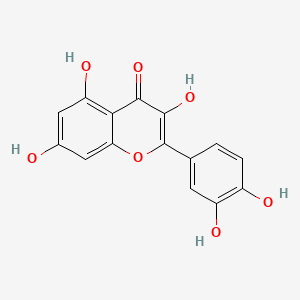| MeSH term | MeSH ID | Detail |
|---|---|---|
| Hemolysis | D006461 | 131 associated lipids |
| Colitis, Ulcerative | D003093 | 24 associated lipids |
| Stomach Ulcer | D013276 | 75 associated lipids |
| Diarrhea | D003967 | 32 associated lipids |
| Diabetes Mellitus | D003920 | 90 associated lipids |
| Uterine Cervical Neoplasms | D002583 | 10 associated lipids |
| Lead Poisoning | D007855 | 4 associated lipids |
| Hypoxia | D000860 | 23 associated lipids |
| Arrhythmias, Cardiac | D001145 | 42 associated lipids |
| Neovascularization, Pathologic | D009389 | 39 associated lipids |
quercetin
quercetin is a lipid of Polyketides (PK) class. Quercetin is associated with abnormalities such as Coronary heart disease, Myocardial Infarction, Cirrhosis, Coronary Arteriosclerosis and Vascular ring. The involved functions are known as Vasodilation, physiological aspects, Fermentation, Process and Ingredient. Quercetin often locates in Arterial system, Endothelium, Skin, Endothelium, Vascular and Tissue specimen. The associated genes with quercetin are P4HTM gene, SULT gene, UGT1A1 gene, ARHGAP26 gene and PLXNB1 gene. The related lipids are blood lipid, Promega, Steroids, Phosphatidylserines and Fatty Acids. The related experimental models are Knock-out, Mouse Model, Xenograft Model, Tissue Model and Cancer Model.
Cross Reference
Introduction
To understand associated biological information of quercetin, we collected biological information of abnormalities, associated pathways, cellular/molecular locations, biological functions, related genes/proteins, lipids and common seen animal/experimental models with organized paragraphs from literatures.
What diseases are associated with quercetin?
quercetin is suspected in Hypertensive disease, Cardiovascular Diseases, Atherosclerosis, Infection, Obesity, Coronary heart disease and other diseases in descending order of the highest number of associated sentences.
Related references are mostly published in these journals:
| Disease | Cross reference | Weighted score | Related literature |
|---|
Possible diseases from mapped MeSH terms on references
We collected disease MeSH terms mapped to the references associated with quercetin
PubChem Associated disorders and diseases
What pathways are associated with quercetin
There are no associated biomedical information in the current reference collection.
PubChem Biomolecular Interactions and Pathways
Link to PubChem Biomolecular Interactions and PathwaysWhat cellular locations are associated with quercetin?
Visualization in cellular structure
Associated locations are in red color. Not associated locations are in black.
Related references are published most in these journals:
| Location | Cross reference | Weighted score | Related literatures |
|---|
What functions are associated with quercetin?
Related references are published most in these journals:
| Function | Cross reference | Weighted score | Related literatures |
|---|
What lipids are associated with quercetin?
Related references are published most in these journals:
| Lipid concept | Cross reference | Weighted score | Related literatures |
|---|
What genes are associated with quercetin?
Related references are published most in these journals:
| Gene | Cross reference | Weighted score | Related literatures |
|---|
What common seen animal models are associated with quercetin?
Mouse Model
Mouse Model are used in the study 'Hepatic cytochrome P-450 reductase-null mice show reduced transcriptional response to quercetin and reveal physiological homeostasis between jejunum and liver.' (Mutch DM et al., 2006), Mouse Model are used in the study 'Heat shock protein 70 increases tumorigenicity and inhibits apoptosis in pancreatic adenocarcinoma.' (Aghdassi A et al., 2007), Mouse Model are used in the study 'Proatherogenic macrophage activities are targeted by the flavonoid quercetin.' (Lara-Guzman OJ et al., 2012) and Mouse Model are used in the study 'Identification of brain-targeted bioactive dietary quercetin-3-O-glucuronide as a novel intervention for Alzheimer's disease.' (Ho L et al., 2013).
Xenograft Model
Xenograft Model are used in the study 'Quercetin induces tumor-selective apoptosis through downregulation of Mcl-1 and activation of Bax.' (Cheng S et al., 2010) and Xenograft Model are used in the study 'Inhibition of carcinogenesis by polyphenols: evidence from laboratory investigations.' (Lambert JD et al., 2005).
Cancer Model
Cancer Model are used in the study 'Modulation of aberrant crypt foci and apoptosis by dietary herbal supplements (quercetin, curcumin, silymarin, ginseng and rutin).' (Volate SR et al., 2005).
Related references are published most in these journals:
| Model | Cross reference | Weighted score | Related literatures |
|---|
NCBI Entrez Crosslinks
All references with quercetin
Download all related citations| Authors | Title | Published | Journal | PubMed Link |
|---|---|---|---|---|
| Wiseman H | The bioavailability of non-nutrient plant factors: dietary flavonoids and phyto-oestrogens. | 1999 | Proc Nutr Soc | pmid:10343351 |
| Boulton DW et al. | Fate of the flavonoid quercetin in human cell lines: chemical instability and metabolism. | 1999 | J. Pharm. Pharmacol. | pmid:10344638 |
| Nagamine S et al. | Effect of androgen structures on the inhibition of metyraponeinreductase in rat, mouse, and human liver. | 1999 | Adv. Exp. Med. Biol. | pmid:10352713 |
| Rzymowska J et al. | The effect of quercetin on induction of apoptosis. | 1999 | Folia Histochem. Cytobiol. | pmid:10352990 |
| Shen F et al. | Synergistic down-regulation of signal transduction and cytotoxicity by tiazofurin and quercetin in human ovarian carcinoma cells. | 1999 | Life Sci. | pmid:10353585 |
| Ciolino HP et al. | Dietary flavonols quercetin and kaempferol are ligands of the aryl hydrocarbon receptor that affect CYP1A1 transcription differentially. | 1999 | Biochem. J. | pmid:10359656 |
| Erlund I et al. | Validated method for the quantitation of quercetin from human plasma using high-performance liquid chromatography with electrochemical detection. | 1999 | J. Chromatogr. B Biomed. Sci. Appl. | pmid:10360437 |
| Graefe EU et al. | Pharmacokinetics and bioavailability of the flavonol quercetin in humans. | 1999 | Int J Clin Pharmacol Ther | pmid:10363620 |
| Izzard RA et al. | Competitive and noncompetitive inhibition of the DNA-dependent protein kinase. | 1999 | Cancer Res. | pmid:10363977 |
| Safety assessment and potential health benefits of food components based on selected scientific criteria. ILSI North America Technical Committee on Food Components for Health Promotion. | 1999 | Crit Rev Food Sci Nutr | pmid:10367185 |
